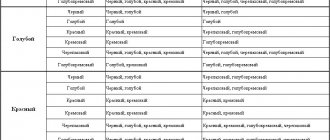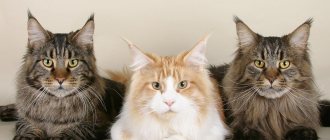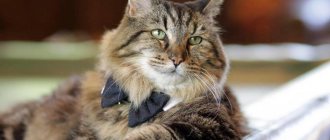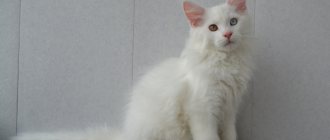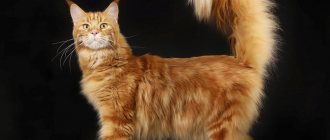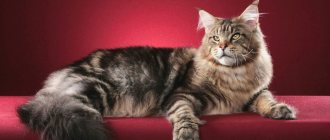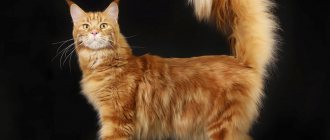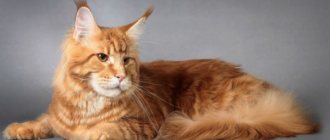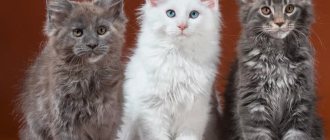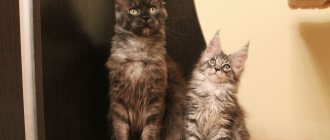From a genetic point of view, Maine Coons have two main coat colors – red and black. All other shades are different variations of the basic ones. All the variety of colors and patterns appears due to the special distribution of hair pigment, which determines the color of the animal.
Determining the hereditary color allows you to find out which cat's offspring will appear. Maine Coons are no exception here. To do this, breeders use special tables with formulas that will tell the color of future kittens. Based on them, you can decide how to cross the adults to get the desired result.
Maine Coons of different shades.
Traditional Maine Coon colors: photos and descriptions
There are several types of coat patterns called tabby.
They all have their own patterns. Tabby was inherited from the wild ancestors of modern domestic Maine Coons. Their distinctive feature is the letter “M”, which is visible in the area of the cat’s forehead and eyes with light or dark lines. There are three types of tabby:
- Tigers. The stripes on the body are parallel to each other.
- Spotted. There are spots of dark and light shades on the sides.
- Classic. Similar to the pattern of marble.
There is also a fourth type - ticked, but it is not typical for this breed. It is usually found in the Abyssinian breed and other oriental cats. It may appear in isolated coon individuals.
Often there are uniform colors in the same range; they are called solid or in the English version - solid (uniform). In this case, the tabby can be almost invisible. Often found in cats that are black in color. The darker the cat, the weaker the pattern of its coat appears. Tabby is especially pronounced in cats with fur of red (red) shades. Solids can be in the following palette:
- black;
- cream;
- red;
- smoky;
- blue.
Smoky gray and blue are of particular interest to Maine Coon breeders, as they are very rare for representatives of this breed. The gallery below shows photos of popular colors.
Maine Coon color calculator
To understand what color will result from crossing animals, breeders use a calculator table. With its help, you can predict with a very high probability what color the offspring of a thoroughbred couple will inherit.
How the coat colors of Maine Coon offspring interbreed.
This is, of course, not a guaranteed result, as it is impossible to calculate the exact genetic combination a kitten will inherit. From time to time, extremely interesting representatives of coons are born, having, for example, tortoiseshell tones, which is very rare for this breed. It has been noticed that most of these individuals are female.
Gray Maine Coon
Gray or blue colors are considered rare for this breed.
An even color of blue shades is a rare occurrence. A smoky shade is usually found. These cats look special; their color gives them their aristocratic charm. If a cat is exactly like this, it means that the gene responsible for the presence of a pattern on the body has been completely suppressed.
Blue tones are specially developed through selective breeding. This takes a lot of time and effort from breeders. The letter “A” is placed in the passport of such a kuna. If the cat has two-color fur, the code “03” is added to the letter designation.
Painted cats
The coat pattern often found among Maines is called tabby or, if pronounced in English, tabby. Scientists claim that tabby is present in the genotype of all cats without exception - they inherited it from their wild forest ancestors. The pattern is obtained due to the fact that, under the influence of a certain gene, the color of cat hair is zoned. Simply put, this means that the hair is not monochrome, but striped, as can be seen upon closer inspection.
Depending on how the light and dark areas are located on an individual hair, one or another pattern is formed on the wool. Tabby is divided into various "patterns", for example:
- brindle color is continuous parallel stripes;
- spotted – intermittent stripes;
- classic - marble stains.
The latter looks best on a black Maine Coon; the black tabby Maine looks surprisingly noble.
tabby color merle
tabby brindle color
tabby color spotted
Elegant ticking
A type of pattern that is uncharacteristic for Maines is ticked. With this color, the entire mass of the coat consists of striped (ticked) hair in the absence of a pronounced pattern (its residual signs can be on the legs, chest and forehead). Ticking is more common among Abyssinian cats; Maine Coons with this color are very rare. These cats look very elegant, especially the black ticked one.
color silver ticked
color red ticked
color ticked
The charm of diversity
Tortoiseshell color is a good omen - many believe that multi-colored cats bring their owners good luck in all endeavors. This may not be true, but they definitely bring joy and aesthetic pleasure.
The pied Maine Coon, especially with “smoke,” is incredibly picturesque. And in this case, it is not so important whether it is a classic “tortoiseshell” (randomly scattered spots of any color except white), or spotted brown, reminiscent of autumn foliage in color, or creamy blue tortoiseshell, combining delicate pastel shades. Without exception, all the “turtles” are magnificent!
tortoiseshell color
smoky tortoiseshell color
color tortoiseshell bicolor
The rarest and most expensive Maine Coon colors
Each breed has rare colors that are not often seen. Maine Coons are no exception. This breed has its own rare shades:
- Brown with spots. These kittens have a color similar to autumn foliage.
- Creamy blue. Looks like tortoiseshell with rare pastel shades.
- Chintz. This is a unique coloring for coons. The base is red, diluted with black tones with white splashes.
- Watered down chintz. There are cream-colored spots on a white background, and blue colors have a solid coloring.
- Spotted with white spots.
Such colors are not typical for coons and are rare.
Smoky
Such cats can be black or blue. The intensity of the haze determines the subspecies:
| Name | Description |
| Chinchilla | Only the tip of the hair is pigmented |
| Shaded | color has a quarter of the hair |
| Smoke | Only the root of the hair is colored white, the main part has black or blue pigments |
| True smoke | Half of the hair has pigmentation |
| Silver | the hair is white at the root, the rest is light silver |
| Cream | at birth, the coat is uniform in color, but gradually becomes unevenly pigmented |
| Classic wild | brindle, marbled black, spotted |
Smoky cats are characterized by white roots. Gray is usually found in monochromatic animals.
Chocolate
The wool is colored brown, warm, rich. The presence of inclusions of other shades or patterns is not allowed. The hairs have an even distribution of pigment. Unlike red tones, it is darker and deeper. Quite rare in breeding. The paw pads and nose also have brown tones.
Classic wild
This color suggests the presence of a pattern on the animal's fur. They can be of different types:
- brindle;
- marble black;
- spotted.
These are the main colors of coons that were common among their wild ancestors.
Peach
These cats have similar features to their cream counterparts. These can be yellow, orange shades characteristic of tabby coons.
Black
Black monochromatic coloring is extremely rare for this breed.
Each black coon has a different color depth and saturation, so it is impossible to find two identical black cats. Usually, this color hides the pattern on the coat. In small kittens it can be difficult to see, but as they grow older it is completely hidden. The cat becomes completely monochrome. An animal with black fur looks regal, luxurious, reminiscent of a majestic panther in appearance.
Black and white
Cats with this coloration have different proportions of these colors:
- Black with white spots. There are several small spots of white on the fur.
- White medallion. A white spot is located on the chest of the animal, reminiscent of decoration.
- White gloves. The cat has black and only white paws of the animal.
- White tuxedo. There is a white shirtfront on the neck, and the paws are also white.
- Bicolor. Black and white in a 1/1 ratio.
- Harlequin. The color is predominantly white with a few black spots.
- Wang. The head and tail are painted black. The rest of the body is white.
What is the danger of white color
White Coons have a predisposition to complete deafness.
It is found in this color much more often than in animals with a different shade of fur. However, there is no need to be upset by this fact. Deaf individuals feel great.
They live well in the house, and are oriented to the area no worse than healthy ones. Their hearing loss is compensated by vision and a keen sense of smell. People who do not know about cat deafness will not guess about it.
Cream
This shade is obtained by lightening the red. The animals are colored in shades similar to raw ginger. When crossing, individuals with genetically weakly expressed pigment in the pedigree are preferred. However, theoretically, even Black Solid Maine Coons can produce cream-colored offspring.
Care and health depending on color
White coat color is recognized as the most dangerous in terms of cat health, which can give the Maine Coon not only charm, but also congenital deafness . By the way, Darwin once pointed out the connection between blue eyes, white color and deafness.
To minimize the risk of such an anomaly, many felinological organizations prohibit mating between two snow-white sires.
To avoid purchasing a deaf animal, you should not buy it through free classified sites or from dubious breeders. Remember that white kittens may have blurry markings on their faces; these usually go away with age.
It is better to wash white wool with special shampoos (for light-colored animals) and not to use conditioners that can give it an unnatural shade.
Owners of black Maine Coons face another type of difficulty - browning and graying of the coat. This usually happens before seasonal molting or, conversely, after a coat change. If your cat does not show off at shows, a change in shade is not fatal.
A Maine Coon vying for the championship title must be flawless - without a “collar” and “pants” that are gray or brown. Proper nutrition, as well as bathing and combing, which stimulate the removal of brown/gray hairs and the active growth of new ones, which eventually acquire a charcoal color, will help get rid of the unwanted shade.
Important! Black kittens are not always born from a pair of completely black Maine Coons. Sometimes a cat brings a litter with babies decorated with white spots in the groin or on the chest.
Return to content
Tortoiseshell
The tortoiseshell Maine Coon comes in two types – torby and torty.
The first type is a combination of red and black shades of wool, expressed in a dark brown color. The torti has a greater addition of red with dark cream. Of particular interest is the fact that tortoiseshell coloring is most often found in cats.
The probability of a male being born with this coloring is approximately 1 in 1000.
On such cats, markings of different sizes and shapes are more clearly visible. Based on the severity of these spots, several colors can be distinguished:
- calico;
- flap;
- chintz.
These cats are characterized by the presence of red shades of fur. The classic color, consisting of three colors, is obtained by mixing black and red. This makes the coat more variegated. There are also several tortoiseshell shades.
Scaly tortoiseshell
Reminiscent of fish scales, the order of spots on the body is checkerboard. These spots alternate in black and red tones and are unevenly distributed. Any one of the colors may predominate.
Calico and solid tortoiseshell (patchwork)
The spots of black and red color resemble flaps. They have defined boundaries and can overlap each other. If the wool has white patches, this color is called “tortoiseshell white” or calico. Red and black spots are solid in color and clearly visible on the animal’s body.
Patterned tortoiseshell
Multi-colored spots have a pronounced pattern. These may be spots or stripes, but marbled colors are also common. There may be small white spots. In this case, it is fashionable to say that the color is spotted tabby or tabby with white spots.
What color Maine Coon is better to choose?
Color, as one of the main details of the exterior, determines the price of a Maine Coon, which is why kittens of the same litter cost differently . Buyer interest is due to two circumstances: the fashion for Maine Coons themselves and a certain color trend.
Now, thanks to the blue Maine Coon Non-plus-Ultra, which appears in commercials, blue solid cats have no competition. This is not surprising - blue solids look amazing, but they are also very expensive in nurseries.
Fans of mysticism and Bulgakov adore cats that are completely black, shell out fantastic money for them and give them infernal names. Slightly lower in the popularity ranking are white solid, snow-white Maine Coons, which might have been ahead of black ones if not for the persistent thesis about a potential hearing disorder.
Cream and red giants are also damn attractive, whose monochrome color slightly disturbs the residual tabby, which is why they still lose to black and blue solids.
If you need a cat with an aura of mystery, take a smoky kitten, whose fur seems to glow from within . Once you learn how to care for such fur, your pet will look no worse than the hyped blue Maine Coons.
This is interesting! Unlike ordinary people, breeders value the so-called wild color - black tabby (including its marbled variation). It is believed that this is how real forest Maine Coons were colored.
Bicolors and harlequins are chosen much less often, which is due to the very unsuccessful play of spots, which do not always form an attractive pattern. And if you accidentally overdo it with white, you can fall out of favor with experts at exhibitions.
People who believe in omens will definitely choose a tortoiseshell-colored cat, which can bring harmony and happiness to the house.
Return to content
Marble colors
Can be cold or warm tones. The first has more gray tones, while the warm one is dominated by brown shades. These stains sparkle in the sun in a special way, which many people like. Such stains can be drawn in different ways - stripes, spots, contours. Such spots can be well defined, then they are more reminiscent of a tortoiseshell color. Marble coloring has more diffuse, blurred borders of spots.
Types of colors
The Maine Coon cat breed comes in a wide range of shades. Among the animals there are individuals with uniform coats, with spots and stripes of unusual shades. There are classic colors that are present in the EMS system with codes and are designated by the letter n. Traditionally it is believed that natural colors are red and black. The remaining shades appeared in the process of mixing the main range. White coloring is considered a complete absence of color. This is an expensive breed that requires careful personal care: the pet must be vaccinated, shown to the veterinarian on time, and fed thoroughly.
The following types of flowers are distinguished:
- cream Maine Coon;
- blue smoke;
- brindle;
- turtle;
- peach;
- calico;
- ashen;
- Brown color;
- black ticked;
- Maine Coon Blue Solid;
- red marble;
- tortoiseshell color.
The shade of a pet's coat is determined genetically.
Tabby
This type of coloring is present in all representatives of the Maine Coon breed, but may not be expressed in a bright form. This color is a genetic predisposition. A cat's hair has its own zoning or striping. The wild ancestors were tabbies, which was inherited by modern representatives. There are various options for this design.
Classic, spotted and brindle tabby
Characterized by wide stripes of a spiral shape. They are usually located on the sides of the animal, and can resemble marble stains. Spotted tabbies have intermittent stripes or spots of color throughout the animal's body. The brindle tabby is similar to the brindle coloring - vertical stripes along the entire length of the body.
Ticked Tabby
These cats have no stripes or spots at all. The fur has a peculiar pattern on the face, paws, and chest. Ticking is the distribution of pigment along the hair. The tip has a rich shade, gradually losing brightness towards its root.
In pedigrees, exhibition catalogs and breed descriptions you can find abbreviations of letters and numbers that are incomprehensible to beginners. Let's try to understand these designations using an example, and also look at the most common colors of Maine Coons. So if you see something like MCO n22, what does it mean? The first three capital letters are the breed designation. For example, PER – Persian, ABY – Abyssinian, BRI – British Shorthair, etc. Accordingly, MCO means that we are talking about the Maine Coon breed. The next lowercase letter indicates the color of the cat's fur. Since there are quite a few acceptable colors for Maine Coons, the letters can be very diverse. For example: w – white – white; n – black – black; a – blue – light blue; d – red – red; e – cream – creamy; f - tortoiseshell - tortoiseshell (normally occurs only in cats, since it is determined by the simultaneous presence of genes responsible for black and red color; the gene responsible for red color is associated with sex and is located on the X chromosome; in cats, therefore, in the only the existing X chromosome can only have one or the other gene, a cat can have both, which leads to tortoiseshell coloration; in cats, the color can only arise due to genetic disorders leading to the presence of an extra chromosome (XXY), and such cats are infertile); g – blue-tortie – blue-cream (the same principle as the tortoise, but with a weakened color). If there is only one such lowercase letter, it means that we are talking about a solid color (solid) - the cat’s fur is evenly colored along the entire length and throughout the body. Sometimes a lowercase s – silver – silver may appear next to it. For example: MCO ns. Silver color means uneven coloring of the hair along the length. After the lowercase letter indicating the color of the coat, numbers may appear that indicate the pattern on the animal's coat. Tabby colors lead to the appearance of a characteristic dark letter “M” on the animal’s forehead, which suits Maine Coons so well, as if specifically emphasizing the breed. So, in our initial example MCO n22, the number 22 means blotched, marble: lighter rims on the eyes, the letter M on the muzzle, wide streaks on the sides in a circle, stripes along the ridge, spots on the belly and ring-shaped streaks on the tail and paws. Tiger color - 23 (mackerel, tiger) - is a pattern of continuous vertical stripes, like a tiger or mackerel (aka mackerel), which is reflected in the name of the color. Spotted Tabby - 24 (spotted) - appears as small spots or intermittent stripes all over the body. The color code may additionally include the designation of white spotting - 09. For example, MCO n 22 09 - black marbled with white color.
Consider the variety of colors of the Maine Coon breed:
Tabbies
If your cat has stripes, then his pattern is “tabby.”
(sometimes they say
“tiger”
).
All tabbies have fine lines on their muzzle that define their eyes and form an "M" on their forehead. If you look at the fur close up, you can see that each hair is colored with dark and light stripes. This alternation is called "Agouti"
.
It is generally accepted that tabby is the original color of wild, undomesticated cats. There are four main tabby
:
- Mackerel tabby (brindle)
- a pattern in the form of parallel vertical stripes. - Classic tabby (classic)
- wide spiral stripes on the sides, reminiscent of marble stains.
In the UK this pattern is called "blotched tabby"
. - Spotted tabby - (spotted)
. Spots throughout the body in the form of intermittent stripes. - Ticked tabby
- sometimes called Abyssinian or agouti. Without stripes or spots on the body, but with a pattern on the face and agouti on the body. This color is typical for Abyssinian cats, but it also occurs in other cats. Ticked colors are not recognized in the Maine Coon breed.
Tabby
come in a wide variety of colors.
Tabby color refers to the color of the stripes or the tip of the tail. The main color of agouti
varies from faded blue to deep red.
Brown classic tabby (black marble
) Wide
spiral stripes on the sides, reminiscent of marble stains. Black stripes on a brown background.
Brown spotted tabby ( black
spotted )
Brown mackerel tabby (black brindle)
Blue classic tabby ( blue
merle )
Red classic tabby ( red merle)
Silver
classic tabby ( silver marble)
Silver marble ( silver tabby)
- black stripes on a white background. The roots of the hair are white. Blue silver, cream silver, or red silver, cameo tabbies are also possible, depending on the color of the stripes. In any case, the silver tabby has a pale base color and white hair roots.
R ed
silver classic tabby (red silver marbled)
Silver
mackerel tabby ( silver brindle)
Cream classic tabby ( cream
marbled )
Solids
If your cat is all the same color, then it is “solid”
.
The British can call its color and “self”
.
Most solid colors have been developed by suppressing recessive tabby
.
Sometimes the pattern is not completely suppressed, then a vague shadow
tabby is visible.
If you have seen a black leopard, you may have seen the outline of the pattern because the leopard also has similar suppressed genes. Red
and
cream
colors cannot effectively suppress tabbies, so the pattern on such animals, to a greater or lesser extent, is always present.
The monochromatic white
color is obtained as a result of the action of different genes that completely suppress the color. Many white kittens have vague shading on the head where the color is not completely suppressed, which goes away with age.
Black solid (black solid)
Red solid (red solid)
Blue
solid
Smoke
(
Smoke
) If the cat
is black
or
blue
, but the roots of the hair are distinctly white, it is
“
smoke
.
” The roots of the hair of solid-colored cats are usually greyish, while true smokes
have distinct
white roots
.
Smokes
are a solid variant
of
silver
tabbies .
This color is very impressive and mysterious, especially in movement, when the color shimmers beautifully. Smokes
are divided according to the length of the colored section of the hair:
- Chinchilla
– 1/8 of the hair tip is dyed. - Shaded
– 1/4 of the end of the hair is colored. - Smoky
– 1/2 of the end of the hair is dyed.
Black
smoke (
Black smoke
) – black with white roots.
Blue smoke ( Blue smoke ) - blue with white roots.
Silver
(
Shaded
/
Chinchilla
)
Silver
(
shaded
or
chinchilla
) – when kittens are born, the coat is so light that it appears white.
However, white color
can only be inherited from white (
not silver
) parents.
tabby
pattern may be present at the tip of the tail , usually disappearing by six weeks.
Green eyes are also a sign that the kitten is silver
and not
white
.
Well-defined white markings
(as opposed to
shaded
spots like the Siamese) can be on any
color
. Just add “ and
white
” to the description of the base color
. This is how you get, for example, “
black and white
”
or “
cream tabby and
white
” .
White areas can be of different sizes and locations, which determine the more precise name of the color:
- with white gloves
(
mitted
) - white slippers on the paws. - with a white medallion
(
locket
) – a white spot on the chest. - with white buttons
(
buttons
) – one or more small white spots. - bicolor
(
bi-color
) - half white. - harlequin
-
mostly white with a few large spots of color . - van
(
van
) - All white with color on the head and tail. - tuxedo
(
tuxedo
) – with white paws and chest.
May have a little white on the head. This is an informal definition. In Maine Coons,
in some feline systems, a lack of white in color, such as
a medallion
or
buttons
, is a disqualifying feature.
Torties
(
Tortoiseshell
),
Patterned
Tabby Torbie
), and
Calico
(
calico
) If your Maine Coon cat has random color combinations, she may be one of the following
colors :
For colors without white:
- Tortoiseshell
(
tortoiseshell
,
tortie
) - random spots throughout the body
of red
,
black
and
cream
. Spots may have varying degrees of clarity. - Blue
-
cream
- random spots throughout the body
of blue
and
cream
colors in soft, pastel colors.
This color is sometimes called blue
or
dilute tortoise
(
blue tortie
,
dilute tortie
). -
Brown
patched tabby
- Reminiscent of fall foliage, with patches of
brown
and
red tabby
.
This color is also known as torbie
. - Blue patched tabby is a soft color with patches of blue and cream tabby.
For colors with white marks, depending on the amount of white:
- Tortoiseshell and white
or
blue-cream and white
- minor
white
areas. The main color is the same as that of simple tortoiseshell or blue cream, respectively. - Calico, Chintz (calico)
- more white.
As a rule, the more white
the red
and
black
should be drawn . Note that the large black spots are usually solid, while the red spots are tabby. - Dilute calico
- the same as the previous one, but with
blue
and
cream
spots. The blue spots are uniform, creamy with tabby. - Patched tabby and white
- varying amounts
of white
.
Tabby
areas with a lot of white, like Calico, have large, clear
patches of color
.
Black torbie with white ( marbled tortoise with white )
Tortie
(
tortoiseshell)
Silver torbie ( silver tortoise with tabby)
Random color combination
Sometimes there are situations when the maine has a color that does not fit any of the color types. For this purpose, its own classification was created. These colors can be called:
- Brown tabby with spots. Such an animal has spots of red and brown.
- Blue spotted tabby. The cat in this case has cream and blue stripes on its body.
- Creamy blue. The spots are scattered in a chaotic manner throughout the body. This color is sometimes called a blue turtle.
- Creamy blue, white.
- Spotted tabby with white spots. The color is similar to the previous one, but there are inclusions of white spots.
Such combinations are also rare.
Maine Coons with white markings
White markings can occur on any Maine Coon color type.
Regardless of whether it is a Maine Coon of chocolate color or any other, each of them will have the same name:
- tuxedo - judging by the name, it becomes clear that the animal has white legs and chest, a white spot on the head is acceptable;
- medallion - a white spot on the chest;
- gloves - white socks on paws;
- buttons - one (or several) white spots;
- harlequin – basic white color with bright spots;
- bicolor – the color is exactly half white;
- van - the kitten is all white with dark spots on the head and tip of the tail.
Unrecognized
Chocolate, gold, and lilac colors are not allowed at specialized exhibitions. Coons with Siamese coat color are also not recognized. There are patterns that are considered unrecognized for the Coons. These can be called:
- faun;
- cinnamon;
- point;
- sorrel;
- acromelanic color.
The coat color of Maine Coons is distinguished by a huge variety of colors and their combinations. The eyes of purebred animals must match the color of their fur. They can be blue (only pure white wool), green, yellow. White individuals may have different colored eyes (blue and green).
Unrecognized colors
Recently, so-called ticked colors have begun to appear. This is unacceptable among this breed. The essence of the color is that one hair has different shades of the same color and, as a result, does not form any pattern.
Siamese colors, chocolate, cinnamon, gold, lilac in its pure form or as an additional color are also unrecognized. There are also types of pattern arrangement that do not correspond to the breed. Animals with such parameters are disqualified and are not allowed to exhibit.
EMS color code
The International Association of Felinologists has developed a table that includes color options recognized by professional breeders. We need such a systematic collection for the convenience of making entries in the pedigree of the animal, bringing information about the breed to a single standard.
Unified table of coat colors according to EMS coding.
Thus, all colors not included in the standard coding are considered coat color defects. Individuals with unrecognized colors are not allowed at exhibitions and are not used in breeding.
However, they are suitable for home keeping in the same way as those with coat colors included in the table. Representatives of this breed have many genetically determined color options. Each Maine Coon is beautiful in its own way, no matter what color nature gave it.
Four main tabby colors
The alternation of dark and light stripes on the Maine Coon's hair is called "agouti". Each of them can be classified into one of four main color types.
- brindle - vertical stripes in the form of clear parallels;
- ticked - considered the most prominent representative of the agouti concept; the animal has practically no stripes on its belly and body, a characteristic pattern is only on the muzzle and tail (some breeders consider this color to be uncharacteristic of the Maine Coon, so we can classify it as a rare Maine Coon color);
- spotted;
- classic - the most common type with wide stripes in the form of spirals on the sides of the animal, which resemble a natural marble pattern.
Classification: basic principles
The Maine Coon color type consists of three components:
- the color of the wool itself
- absence or presence of a pattern on the cover
- presence of spots, their color and size.
As for the classic shade of wool, felinology claims that there can only be two original colors: black and red. By red Maine Coons we mean cats that are commonly called red in everyday life. The remaining existing variations in shades are the result of oxidation or lightening of the pigment under the influence of external factors and the genetic characteristics of a particular individual.
The pattern on the fur of Maine Coons can be very diverse, most often it is a combination of stripes of different thicknesses and lengths, sometimes turning into curls.
The spots can either complement the line pattern or be a separate part of the coat color. The absence of lines with a large number of randomly located spots is a sign of the tortoiseshell color of the Maine Coon.
Determining the color of a Maine Coon requires a lot of experience and both the ability to distinguish between principles common to all cat breeds and knowledge of genetics and the characteristics of a particular breed. To simplify this task, an EMS table was created within the framework of felinology, which includes all possible color options for purebred Maine Coons.
© shutterstock
Solid colors
The name “solid” was given to cats whose fur is completely the same color.
The monochromatic color is the result of the painstaking work of breeders, and it is quite difficult to find it. Often, upon careful examination of the cat, you will notice a subtle tabby pattern.
The Maine Coon is especially impressive because it is white in color with different or bright yellow eyes. Agree, the impressive size of the cat with white fur, which in addition makes him look fat, will not leave any fan of this breed indifferent.
The Maine Coon Solid black color is in no way inferior to white cats. Many lovers of this breed wait for many years to acquire such great happiness.
Maine Coon blue solid
Maine Coon black solid
Maine Coons white solid
Maine Coon red solid But completely red and red Maine Coons are acquired not only due to their bright appearance. Most animal psychologists, observing the behavior and intelligence of raccoon cats, have come to the conclusion that it is these pets that are the most intelligent among their fellows.
Numbers and letters in color designation
MSO is the breed itself - Maine Coon . The lowercase w represents the color of the coat. There are many colors and therefore these letters are different. Here are the main notations:
- W – white – white;
- N – black – black;
- A - blue - blue;
- D – red – red;
- E – cream – cream;
- F – tortoiseshell – tortoiseshell;
- G – blue-cream – bluetortie.
When the breed description contains only one of the above letters, it means that the coat has a uniform, solid Maine Coon color. The combination of letters, on the contrary, indicates uneven coloring of the hair.
The designation of patterns on a Maine Coon is made by the very numbers that come after the letter combination. In our case, 22 are marble shades: eye rims, streaks on the sides, stripes along the ridge, streaks on the paws and tail.
23 – Maine Coon brindle color. The pattern will have vertical stripes, similar to a mackerel or tiger.
24 – broken stripes and white spots, etc.
Having looked at the variety of combinations, let's turn to the main types of Maine Coon colors that are most often found.
Bicolor individuals
Ticked
The ticked color is characteristic of animals of other breeds, but occasionally occurs in Maine Coons.
Other names are agouti or Abessinian color. Such pets are classified as tabby. Cats with this pattern are characterized by black parallel stripes on the upper part of the face. But there are no patterns on the body and there is only a single dark shade. Often this type of coloring is found in other breeds, is not recognized in Maine Coons and is not included in the classification of colors of this type of animal.
brindle tabby
This ticked color in Maine Coons is considered a wild color: the pet has vertical elongated stripes throughout the body. Parallel interrupted stripes are less common, but such a pattern is not considered defective and is recognized by the classification. Less commonly, peach-colored tri-colored tabbies are combined with small spots on the cat's ribs. The pattern is sometimes called "mackerel" due to its resemblance to the fish of the same name. The lighter the cat's coat, the more noticeable the tabby.
